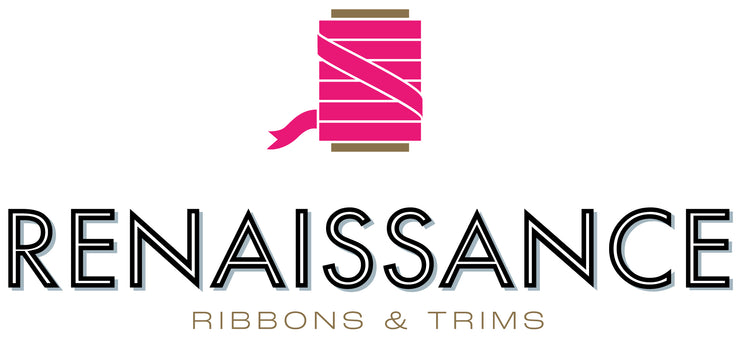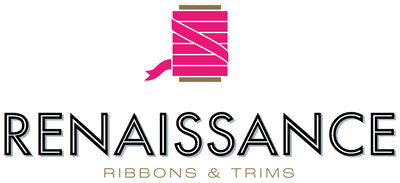Tips on Sewing with Ribbons

Mastering Ribbon Sewing: Essential Tips and Techniques for Perfecting Your Craft
A touch of ribbon can elevate any DIY project, adding vibrant colors and captivating visual appeal. While gluing ribbons is a quick fix, sewing them offers better durability and a professional finish. In this blog post, we will explore essential tips and techniques for sewing with ribbons. With a focus on Renaissance Ribbons, known for their exquisite woven designs, you'll discover how to create stunning fashion accessories, embellishments, and home decor pieces. Let's dive in!
Most of Renaissance Ribbons are woven ribbons, also called embroidered, brocade or tapestry ribbons, in that these are ribbons with designs woven into it. They have a front and back and the intricate designs on the ribbon makes it very suitable for elaborate projects such as fashion accessories, home decor and embellishment in general.

This post includes tips for sewing with woven ribbons.
- If you are making a project that will be laundered, such as a skirt or placemats, make sure to pre-wash and dry the base fabric as you would the finished project before you begin sewing. Fabrics can shrink quite a bit when laundered, especially cottons and linens, and that can cause the ribbons to not lie flat after the project is washed.
- Since Renaissance Ribbons are woven of polyester that will not shrink, it is not necessary to pre-shrink them, although you could certainly pre-wash and dry them with the fabric. Just make sure to machine zigzag stitch across the cut edges so they do not unravel. I find that lightly pressing them with a steam iron and pressing cloth also works to smooth them and prepare them for sewing.

- Take care when ironing polyester ribbons as they require a lower ironing temperature than cotton and linen fabric. When sewn to the fabric, I like to press the ribbons from the wrong side of the fabric or use a pressing cloth to protect them from the heat.
- Use a see-through quilting ruler to position ribbons onto your project equal distance from an edge. Dressmaker’s chalk or an air or water soluble marker are helpful for marking placement lines.
- To eliminate the need for pins and to keep ribbons from shifting as you are sewing them in place, apply a little basting glue or strips of lightweight fusible web, such as Steam-a-Seam, to the wrong side of the ribbon. Follow the manufacturer’s instructions and test to make sure the ribbon can be easily stitched without the adhesive gumming up the needle. Some adhesives are not meant to be sewn through.
- NEW TIP: we love the new ByAnnie Double Basting tape in 3mm perfect for positioning the ribbons and will soon make it available in our store!

- Use a sharp hand or machine needle that will not snag the ribbon when it is stitched. The needle should be fine enough so that holes it creates in the ribbon are just large enough for the sewing thread.
- Stitching ribbons to the flat fabric before the project is constructed allows for the raw edges of the ribbons to be caught in the seam allowance. If trimming a ready-made article, open up the seams a little to allow the ribbon joins to be hidden inside. Or, add a seam allowance to the ends of the ribbon and turn the cut edges under before stitching in place.
Machine Stitching Ribbons:

- I use a size 75 or 80 needle in my sewing machine when stitching ribbons.
- Use polyester sewing thread. Machine embroidery thread may also be used for more densely sewn decorative stitches. Coordinate the thread color with the ribbon. Match the ribbon color for a less visible attachment or select a contrasting color for added interest.
- Always sew in the same direction on both sides of the ribbon. This will prevent any shifting and puckering.
- Make a sample to test the stitch length and machine tension. You can use straight stitches, narrow zigzags or overcast stitches that will just catch the edges of the ribbon. Check out some of your machine’s decorative stitches when making your sample. You might find one that really enhances the design of your selected ribbon. Experiment with the width and length of the stitches and different types and colors of thread. If decorative stitches cause puckering when sewn, add one or two layers of stabilizer under the fabric.

Hand Sewing Ribbons:
- Hand sewing is best when sewing velvet or intricate jacquard ribbons or when machine stitching may show and interfere with the design of the ribbon.
- Use a fine needle and select a thread color that matches the edge of the ribbon.
- Sew hand slipstitches close to the edge of the ribbon to provide an almost invisible finish.
- To form slipstitches, bring a threaded needle to the front of the background fabric. Take a tiny stitch just into the edge of the ribbon. Bring the thread back into the fabric, making stitches every ¼” and spacing them evenly along the length of the ribbon.
- A small bead can be sewn in place with each slip stitch to add additional detail to the ribbon.
- Add a tiny ric-rac along the edges and embellish with contrasting color thread and a slip stitch!
Have fun sewing with ribbons!
I Hope these hints & tips will encourage you to start sewing with the ribbons you might have in your stash. Next time you are tempted at the store, go ahead and pick up a yard or two of your favorites. I am sure you will find just the perfect way to use them to add that touch of “wow” to your projects.
and of course on our site we have them all!
Explore the versatility of ribbons and get inspired by more project ideas:
- Fashion accessories: Embellish headbands, hair clips, or handbags with ribbons to add a pop of color and style.
- Home decor: Sew ribbons onto pillow covers, curtains, or lampshades to create unique and personalized accents.
Ribbon Art! Create your own Ribbon Art
Embark on a creative journey and delve into the captivating world of Ribbon Art!
Discover the joy of creating your own unique pieces by stitching ribbons together to craft stunning works of art. With the simple technique of using a zigzag stitch to seamlessly connect ribbons of various widths and colors, you can bring your artistic vision to life, resulting in mesmerizing and textured fabric compositions. Unleash your creativity as you experiment with different ribbon placements, allowing you to design captivating patterns and intricate designs that truly stand out.
Once completed, your Ribbon Art creations can be showcased as exquisite mini quilts, perfect for framing and adorning your walls with a touch of artistic flair. Additionally, you can use your fabric as the exterior material for various crafts, such as pouches or decorative accents, adding a unique touch to your handmade creations.
Start your Ribbon Art journey today and unlock the endless possibilities of this captivating art form that allows you to express your individual style and imagination.
Here is my Ribbon Art creation this week end! A Ribbon Chevron Pouch!
Get the Free PDF pattern if you want to give it a try!


Thanks for being a Ribbon Lover!



Hiya, I’m wondering if it is possible to sew curved ribbon lines with a gathering stitch to curve them?
Otherwise, lovely tips, thanks!
What a super thought out , wonderful and well written article ……all the ideas and tips will be so helpful for me and even tone else when we are all adding Renaissance Ribbons gorgeous ribbons to our projects :). Thanks for taking the time to write this article and for sharing it with all of us….
Leave a comment